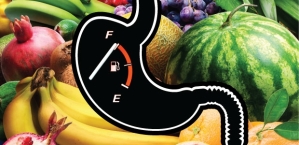Satiety – definition: the state of being full or gratified to or beyond the point of satisfaction.
If you are familiar with Monty Python, you were probably reminded of the Mr. Creosote sketch when you read this word. A fictional character in Monty Python’s ‘The Meaning of Life movie, he is a monstrously obese restaurant patron. During the sketch he consumes a vast amount of food while vomiting repeatedly. (Yes, its disgusting!) Once sated he asks for the bill but is persuaded by the maitre d’ to finished off his huge meal with a ‘wafer thin mint’. After placing the mint in front of Mr. Creosote the waiter runs for cover. The reason becomes clear when Mr. Creosote explodes!
There is certainly mischief in the maitre d’ actions and Mr. Creosote’s pompous personality shows through. The character building in this short sketch is well done as you understand the restaurant staff have suffered with this particular patron for some time.
When we are creating our characters we hope to develop them well enough that our readers ‘know’ them as true personalities within the beginning stages of the narrative. If the reader only discovers vital information about our protagonist in the middle of the story, it is probable we have lost that reader. There needs to be empathy with our character. We have to custom build our unique ‘world’ and ensure our characters ‘fit’ into that scenario.
We can begin with the physical characteristics, such as height, weight, build and hair and eye colour but these are only the start. To ensure we have a rounded being for our readers to envisage, we need to ‘know’ each character. What are their habits, quirks or eccentricities, beliefs, likes and dislikes, fears, temperament, hopes and dreams. In short what does their ‘life’ look like and consist of.
Developing character bio’s is not just a fun exercise but also a great writing tool. You have a firm base with which to develop your story and how each character reacts as they are true to their personality. However, remember to leave as much as possible to the reader’s imagination, the bio is for your use not theirs. Every reader wants to visualize the characters and doesn’t want a full blown description as if your character is looking in a mirror.
Do you have a character bio step by step?





